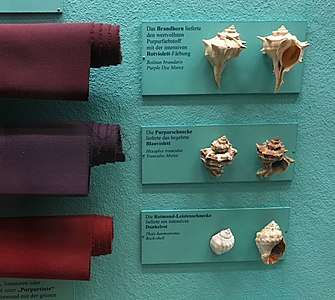Stramonita haemastoma
Stramonita haemastoma, common name the red-mouthed rock shell or the Florida dog winkle, is a species of predatory sea snail, a marine gastropod mollusc in the family Muricidae, the rock snails.[1]
| Stramonita haemastoma | |
|---|---|
| Stramonita haemastoma shell | |
| Scientific classification | |
| Kingdom: | |
| Phylum: | |
| Class: | |
| (unranked): | |
| Superfamily: | |
| Family: | |
| Subfamily: | |
| Genus: | |
| Species: | S. haemastoma |
| Binomial name | |
| Stramonita haemastoma (Linnaeus, 1767) | |
| Synonyms[1] | |
| |
Distribution
The red-mouthed rock shell occurs widely in tropical and warm water areas of the Western Atlantic Ocean. Regions where it can be found include the Caribbean Sea, North Carolina and Florida, Bermuda and the entire Brazilian coast, including the islands of Abrolhos and Fernando de Noronha. It is also found in the Eastern Atlantic: tropical Western Africa and Southwestern Africa, including Cape Verde and Angola, and in European waters, including Macaronesian Islands, the Mediterranean Sea and the southwest coast of Apulia.[1][3][4] Canary Islands. Its once abundant population in the Eastern Mediterranean collapsed early in the 21st century and had entirely disappeared by 2016.[5][6]
Description
The adult shell size for this species varies between 22 mm and 120 mm.
Feeding habits
Stramonita haemastoma is a widespread gastropod that consumes bivalves, barnacles and limpets. In the Mediterranean Sea the whelk is an important predator of the bivalve Mytilaster minimus, but where the invasive Lessepsian migrant bivalve Brachidontes pharaonis is found, the whelk prefers to prey on that species over the native bivalves and barnacles.[7] Through feeding behaviors such as attacking the margin or lip of shells where defenses are weakest, Stramonita haemastoma insert its proboscid between the valves injecting proteolytic enzymes and a toxin that causes bivalves to gape.[2][8]
Human use

The shell was one of two principal sources of Tyrian purple, a highly prized dye used in classical times for the clothing of royalty, as recorded by Aristotle and Pliny the Elder.[5]
References
- Stramonita haemastoma (Linnaeus, 1767). Retrieved through: World Register of Marine Species on 17 December 2018.
- Watanabe, J.T. & Young, C.M. 2006. Feeding habits and phenotypic changes in proboscis length in the southern oyster drill, Stramonita haemastoma (Gastropoda: Muricidae), on Florida sabellariid worm reefs. Marine biology, 148:1021-1029.
- Leal, J. H. (2002). "Gastropods" (PDF). In Carpenter, K. E. (ed.). The living marine resources of the Western Central Atlantic. FAO Species Identification Guide for Fishery Purposes and American Society of Ichthyologists and Herpetologists Special Publication No. 5. 1: Introduction, molluscs, crustaceans, hagfishes, sharks, batoid fishes, and chimaeras. Rome: FAO. pp. 128–132. ISBN 978-92-5-104825-2.
- "Conquiliologistas do Brasil". Thais haemastoma (Linnaeus, 1767). 2001–2010. Retrieved 3 April 2010.
- Beaumont, Peter (5 December 2016). "Ancient shellfish used for purple dye vanishes from eastern Med". BBC. Retrieved 6 December 2016.
- Rilov, Gil (17 November 2016). "Multi-species collapses at the warm edge of a warming sea". Scientific Reports. 6: 36897. doi:10.1038/srep36897. PMC 5113072. PMID 27853237.
- Giacoletti, A., Rinaldi, A., Mercurio, M., Mirto, S. and Sarà, G. 2016. "Local consumers are the first line to control biological invasions: a case of study with the whelk Stramonita haemastoma (Gastropoda: Muricidae)". Hydrobiologia. 772:117–129.
- McGraw, K.A., Gunter, G. 1972. Observations on killing of the Virginia oyster by the gulf oyster borer, Thais haemastoma, with evidence for a paralytic secretion. Proc Nat Shellfish Assoc 62:95–97.
Further reading
- Bernard, P.A. (Ed.) (1984). Coquillages du Gabon [Shells of Gabon]. Pierre A. Bernard: Libreville, Gabon. 140, 75 plates
- Gofas, S.; Afonso, J.P.; Brandào, M. (Ed.). (S.a.). Conchas e Moluscos de Angola = Coquillages et Mollusques d'Angola. [Shells and molluscs of Angola]. Universidade Agostinho / Elf Aquitaine Angola: Angola. 140 pp
- Gofas, S.; Le Renard, J.; Bouchet, P. (2001). Mollusca, in: Costello, M.J. et al. (Ed.) (2001). European register of marine species: a check-list of the marine species in Europe and a bibliography of guides to their identification. Collection Patrimoines Naturels, 50: pp. 180–213
- Rolán E., 2005. Malacological Fauna From The Cape Verde Archipelago. Part 1, Polyplacophora and Gastropoda
- Rosenberg, G., F. Moretzsohn, and E. F. García. 2009. Gastropoda (Mollusca) of the Gulf of Mexico, Pp. 579–699 in Felder, D.L. and D.K. Camp (eds.), Gulf of Mexico–Origins, Waters, and Biota. Biodiversity. Texas A&M Press, College Station, Texas.
- Ramírez R., Tuya F. & Haroun R. J. (2009) "Spatial patterns in the population structure of the whelk Stramonita haemastoma (Linnaeus, 1766) (Gastropoda: Muricidae) in the Canarian Archipelago (eastern Atlantic)". Scientia Marina 73(3) doi:10.3989/scimar.2009.73n3431
External links
- "Stramonita haemastoma haemastoma". Gastropods.com. Retrieved 10 January 2011.